#Shinto Path
Explore tagged Tumblr posts
Photo
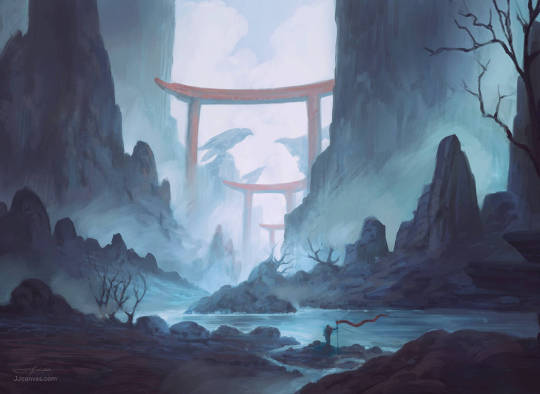
Shinto Path - JJcanvas
69 notes
·
View notes
Text
Shinto Shrine




#yume nikki fangame#ynfg#yume 2kki#urotsuki#rpg maker 2000#32 bit#shinto shrine#shinto#shrine#maiko#effect#effects#sabamiso#maiko ghost#cherry blossom#cherry blossom tree#sakura#sakura tree#branch#sakura path#ghost girl#ghost#ghosts
11 notes
·
View notes
Text
Kunitsu-Gami seems to be exactly the type of action game out of the mainstream gaming industry I’ve been eager for lately. A Shinto-influenced Mythological Fantasy setting that steps away from straight up and down western medieval fantasy, one part plate-spinning Tower Defense + one part flashy character action, and an Original IP not locked to the current obsession with live service elements or always online requirements which gaming execs have drooled over the past near decade. Shot up to the top of my wishlist after the Gameplay Overview Trailer:
youtube
In many ways, like Hi-Fi Rush before it, it injects a similar bit of hope in me for at least a part of the AAA gaming industry that hasn’t been sapped away through tripe like Kill The Justice League, Marvel Avengers, Starfield, Gotham Knights, AC Valhalla, Skull & Bones, Silent Hill Ascension etc. I’ve got nothing but kudos to grant Capcom for both this & Dragon’s Dogma 2!
#capcom#kunitsu gami#kunitsu gami: path of the goddess#kunitsu-gami#video games#Shinto#Shinto mythology#Japanese fantasy#hi fi rush#japanese mythology#gaming industry#character action games#action games#tower defense#tower defense games#original ip#suicide squad ktjl#Ubisoft#bethesda#starfield#aaa gaming#aa gaming#Konami#skull & bones#Youtube
3 notes
·
View notes
Text
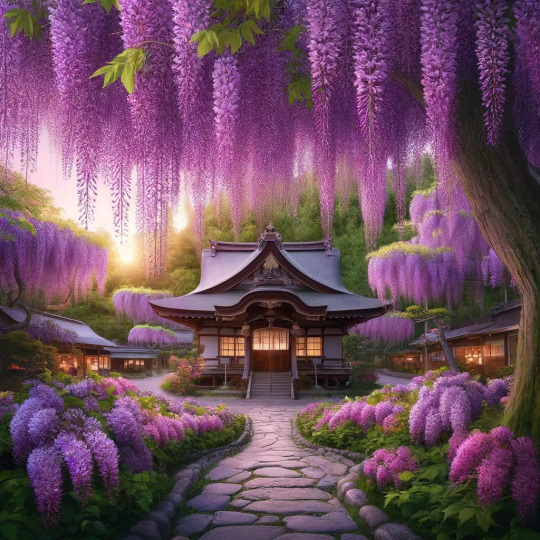
AI image generation
1 note
·
View note
Text
Entanglement, Impurity, and Kegare in Rain World
I mentioned before in another post that I would touch on the topic of impurity, rot, and kegare and how it continuously reappears in Vanilla and ESPECIALLY Watcher. Here it is.
But yes, it can't really be understated how important these are to the themes lore of ascension and entanglement in RW and the dichotomy that exists
This topic relates to FP, Hunter, Watcher, and the Ancients. It's all over the place man.
I actually got this idea from Darthz, who was the one who brought it up to me initially. I'm just expanding on it and writing it all down further
What is Kegare and Why Am I Bringing It Up
Kegare is a Shinto concept. Specifically it represents pollution alongside magakoto (abnormality) and tsumi (imperfection). The avoidance of these taboos itself is called imi. Though I'm only mentioning kegare, technically I am referring to all 3 of these terms (to make things easier)
It was accumulated through and/or caused by being victim of disaster, proximity to death, being physically unclean, committing terrible actions, or even childbirth (for sexism reasons. Don't worry about it)
It operates very similarly to karma, being determined by cause and effect and was amoral and natural. Though it was taboo, and those who may have had it were avoided, it was not out of sinful reasoning
"Also, suffering is not regarded as a form of punishment for human behavior, but, rather, as a natural element of human experience."
Having too much kegare would bring more misfortune, illness, and disaster with whoever carried it
About the Ancients and Karma Gates
The ancients themselves seem to ALSO have a taboo of a similar nature.
"May Not as long as the Stars stay fixed on their Celestial Spheres Grey Hand, Impure Blood, Inheritable Corruption, Parasites, or malfunction settle in Your establishment."
Though this isn't much to go off of.
Though maybe we can look to some outside sources. The steam released by the karma gates is said to be decontaminating. This is big. This is huge



Here you can see the steam coming out of either a vent below the grate, or coming off a heating coil, before the other side opens up.
These gates exist and were built in order to filter out and decontaminate whoever passes through, similar to harae. You wouldn't want any impurities passing through your temples and homes and facilities, would you?
"...and when the production was automated it would generally remain on the same site. So that the old stones could... radiate the material with holiness, I suppose."
Even in industrially automated processes, there was some spiritualism involved. Decontamination may have been pretty important as to not dirty up those so called holy stones
You see these gates in front of the AU voidbath and the path to FP in a long hallway. You even see it in Verdant Waterways, which may have just been a huge water purification plant! So the decontamination is still a factor there
Ancient Urban, FP's Roof, and Verdant Waterways in order.



"I was embalmed, adorned, readied for the journey."
If being dunked in void fluid required you to first be embalmed and sterilized, what does that imply? There was a worry of decomposition or decay when it came to the process of ascension.
About Five Pebbles and Hunter
Now seeing how kegare exists within the beliefs or actions of the Ancients and how much they wanted to prevent it from settling, what about seeing the consequences for yourself?


Five Pebbles contracted the rot after essentially killing Moon, something that would cause kegare (or, specifically tsumi here). He tried to break his taboos and ended up entangling himself further and also terribly hurting someone else, bringing with him sorrow that he tries to make up for in Hunter (see how often he mentions Moon?)
Though yes, it was CERTAINLY caused by him fucking up an experiment. Metaphorically, it is a form of kegare
Even the wording for the rot. Unfortunate... corruption... its a natural but terrible thing that happens
"He's sick, you know. Being corrupted from the inside by his own experiments.""...on his first fit of corruption he dumped a lot of infected material there..."
I even feel that the one off dialogue about FP and not using holy ash was subtle foreshadowing to what he's experiencing
Even in the only other place rot appears and spreads in is an actual DUMP!
But what about Hunter?
I believe that Hunter and Five Pebbles are intended to be narrative parallels to each other, having tried to change themselves in an act of desperation, but failing and contracting a disease.
"We both have something... unfortunate growing in us."
But how did Hunter get this "unfortunate" disease? Is it even The Rot?
Well... it's not directly the rot. But it's confirmed to be RELATED to it.

As for the cause of Hunter's disorder? I think this quote from the 1.5 kickstarter announcement can answer part of it.
"...It is a being pushing beyond the confines of its place in the ecosystem, and thus is karmically imbalanced in this world."
This is likely because of the fact that Hunter CHOSE to start killing and eating meat when it previously did not need to. It engaged with unsanitary acts of eating raw meat and hunting and killing, possibly out of desperation
And considering Hunter's disease, this and the karmic imbalance could very much be tied into each other. The fact that Hunter also accepts to deliver the Green Neuron, when it could have simply abandoned at any point, also shows that they're willing to also make up for the misfortune they carry, similar to Five Pebbles
Whatever it is, its clear disease, desperation, and karmic alignment all correspond and relate to each other. This desperation which is entangling, and which the Drainage pearl warns about, how struggling in the fishing net only results in you being more tangled in it
Also, the use of unfortunate in that pearl is not lost on me
"It says that the world is an unfortunate mess."
About Watcher
Watcher definitely ALSO leans into the uncleanliness aspect, as you can tell with the absurd amount of rot that's around everywhere
As well as this... there are no karma gates. The warps cannot cleanse you of whatever you carry between regions. Both ST and Watcher are like 2 kids dragging mud (rot) with them where they go
"So glad I cannot sniff! Spoiled meat, dissolving proteins. Yeeck."
There are entire regions dedicated to just this raw Pollution. It's disgusting and dirty and nobody wants to be in it, yet its clear this is just a natural thing. An unfortunate reality
The rot IS just straight up entanglement and the embodiment of the cycle itself, only existing to Consume and Reproduce. Its sticky and web-like, it corrupts and eats and decays. It's pretty in your face about what it is. The fact FP caught it while being desperate...? But I already talked about that before.
As well as this, Outer Rim is caked in mud, and so is Badlands (which warps to Unfortunate Evolution). These are the only places currently that have mud at all, and both lead to rot one way or another. The regions themselves Are Just Disgusting
Not to mention Station Annex (which also leads to UE) is just littered with lizard corpses...


Conclusion
Rot is kegare. A pollution of existence that is brought by disaster or terrible actions, and which causes misfortune and brings even more disaster
The Ancients themselves must have known of this- or at least known of a similar phenomenon to the rot with the same root and effect, and so built karma gates and continued practices to keep themselves clean while they lived and while they ascended
#textadactyl#theory#watcher#fp#five pebbles#hunter#spinning top#sentient rot#watcher dlc#lore#narrative analysis#rain world#ancients
124 notes
·
View notes
Text
Ever since the final chapter of Jujutsu Kaisen came out, I‘ve been wondering who this woman is, that we see in Sukuna‘s final panels. So I decided to read a bit. (Maybe I‘m hella late and y‘all already know this stuff or it‘s already fully settled who this is idk I wasn‘t active until last week lol)

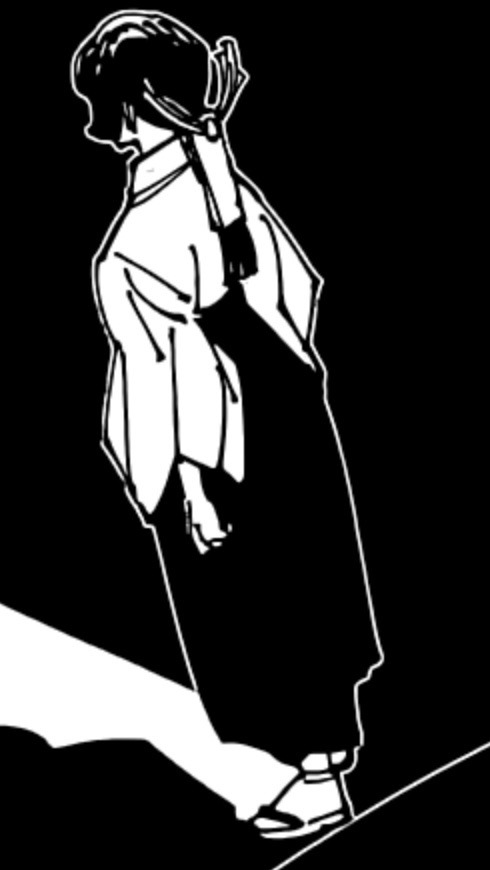
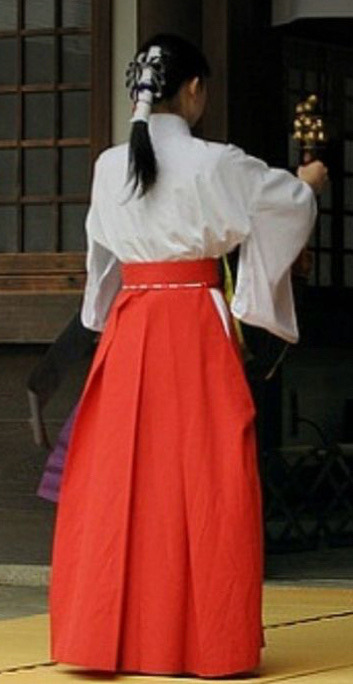
The woman appears to be a Miko, a type of priestess that works at shinto shrines. This source describes their duty as the following:

In general, Mikos remained virginal and unmarried for their entire lives. Until the late Heian period, mikos could be married to Yamabushi who belonged to the Shugendō religion. However, these were purely ritual-formal marriages that remained childless. (Wikipedia / Joseph Cali, John Dougill: Shintō Shrines)
Back to the Manga: some people assumed this woman must be Yorozu, since it‘s one of the persons who offered love to Sukuna. However, for me, there is no indication at all that Yorozu of all people, is a virgin, let alone a devoted priestess.

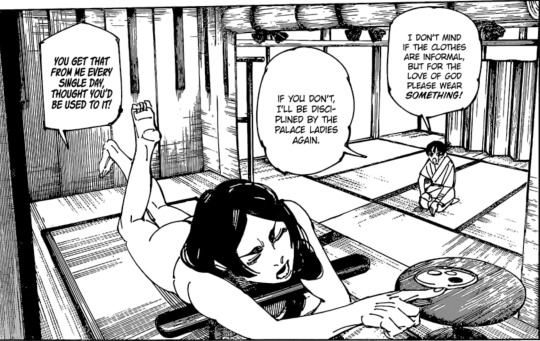
My personal first thought was, that this woman is Sukuna‘s mother. The only parent Sukuna ever mentioned is his mother. He also hinted at his childhood as well.
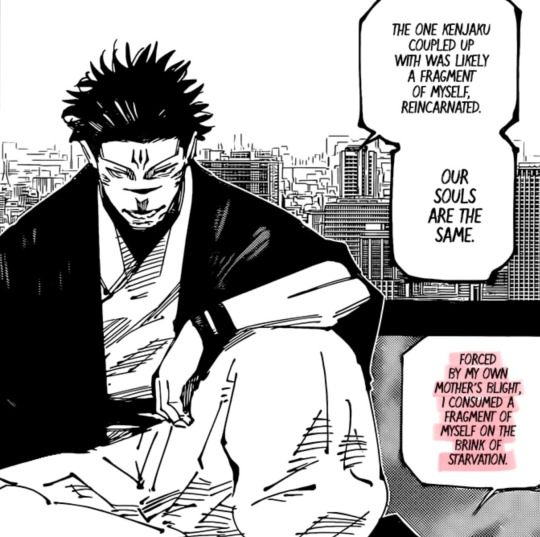

If we assume Sukuna‘s mother was a Miko, Sukuna‘s fate of being unwanted and at the brink of starvation would make sense, since Miko were expected to be childless.
So how could this have happened? As I mentioned above, until the Heian Period they were allowed to have ritual formal marriages with Yamabushi. They also were supposed to remain childless.
But who are the Yamabushi anyway? The followers of Shugendō performed magical-religious rituals and ascetic practices in the mountains with the aim of “becoming Buddha in this life” (sokushin-jōbutsu <<< Hah ring a bell?) and gaining supernatural abilities. These abilities are used for the benefit of the population, for example in the form of fortune-telling or to cure illnesses. (Wikipedia)
This sounds very Sukuna esque for me lol
Doesn‘t prove anything but I think it‘s interesting to mention.
ANYWAY
What if Suku‘s momma was married to one of the Yamabushi? What if they were just… human and did fell in love, putting their duty aside? Getting Suku‘s momma pregnant, and probably punishing her for it. Sukuna was unwanted after all, not only bcs of his appearance but bcs of the circumstances as well.
What‘s super interesting is, what is mentioned earlier, that up until the late Heian Period, Miko were primarily young girls from noble families. So Sukuna being the abomination that he is being born into the forbidden circumstances AND disgracing his mother and her family. Yea… unwanted little wretch.
However.
Maybe none of this is true and the Miko woman is just a symbol for the religious path he could have followed.
Who knows?
Not me. Apparently.
Any further information is very welcome!
#sukuna analysis#nighty thoughts#sukuna#true form sukuna#jjk#jujutsu kaisen#sukuna jjk#theory#kinda#ryomen sukuna
199 notes
·
View notes
Text
Triptych | "Fate put us on the same path."

Chisaki Kai x f!Reader
summary: Your life is nothing more than a triptych, a work of art in three parts with each panel depicting a distinct period — a beginning, a middle, an end. And in the triptych that is your life, the central figure has always been Chisaki Kai.
chapter warnings: 18+ minors/ageless/blank blogs dni, yandere, possessive behavior, emotional manipulation, complicated family dynamics, codependency, daddy issues, abandonment issues, reader says "faults" but should really be saying "red flags" lol
notes: this is from a non-chronological series so the parts can be read (mostly) on their own or in any order. someone left the nicest comment on this fic on ao3 and I felt like I needed to update this fic, so this is your regular psa on the importance of leaving comments!
words: 2.2k
SERIES MASTERLIST
minors, blank, and ageless blogs do not like, comment, or reblog

The Middle

You’re having trouble breathing. You’re having literal trouble breathing.
The shiromuku is so heavy and tied so tightly that it feels like each breath you take requires a monumental effort. There’s an ache forming in your shoulders from the pure weight of it all. You’ve spent so much of your life in kimono that you can put one on blindfolded. But this? This wedding kimono is another beast entirely.
“It’s a bit tight,” you wince, causing the two women currently in the process of tying the obi around your middle in an extravagant knot to softly titter.
“I know. It’s all a bit cumbersome,” the older woman in front of you commiserates before smiling at you so kindly that it alleviates your discomfort for a brief moment. “But it’s worth it. You look beautiful, just as every bride should. Your husband is a lucky man.”
You let out a noncommittal hum, which is cut short by a soft grunt when the woman behind you gives your obi a particularly harsh yank.
“How did the two of you meet?” she asks, trying to distract you from how uncomfortable you feel as they continue to tie you up in beautiful silk.
“We grew up together,” you reply, deciding the simplest answer is the easiest.
“Ah, so fate put you both on the same path,” she observes with a soft smile and her words have you suddenly feeling breathless for a reason entirely unrelated to the thick layers of fabric wrapped around you.
“I guess so,” you murmur, but before you can lose yourself in your thoughts, you wince when your obi is given one final tug.
“There we go,” the older attendant behind you declares proudly as she adjusts the obi knot. As difficult as it physically is to do so, you sigh with relief knowing that the fussing is almost over. It’s been over an hour by this point. “All that’s left is the uchikake.”
One of the women lifts up the final and thickest layer that will be worn over your kimono. You reach out to gently trace the beautiful designs embroidered on the white silk. As your finger follows the outline of a crane’s beak, you can’t help the frown that forms on your lips.
“Can we take a break?” you ask and there’s a pause at your unexpected request.
“O-of course,” the attendant in front of you says as she carefully places the uchikake back in its box before she and the other woman leave the room.
When you hear the door close behind you, your posture droops as much as it can in such a restrictive kimono. Instinctively, you tug at the collar to try and loosen it slightly at the neck only to immediately worry that you’ve ruined the women’s hard work.
You turn towards the room’s floor-length mirror and feel a rush of relief when you see that the collar appears untouched. Your eyes then drift to take in your full reflection for the first time and your lips part slightly in surprise.
So much of your life has been dictated by tradition — from the way you were raised to the clothing you had been made to wear to the marriage that your father tried to arrange for you — that the last thing you wanted was a traditional Shinto wedding ceremony. However, as you see how beautiful the shiromuku is, and how elegant you look in it, you’re in awe.
But the longer you look at yourself, the more reality begins to set back in until the small frown on your face is reflected at you in the mirror. Without the distraction of the two women dressing you in such an elaborate garment, all you’re left with is the image of someone you don’t recognize — or rather the image of a future that you never envisioned for yourself.
Eventually, the reflection becomes too much and you turn away from it to look out the window into the shrine’s gardens. When you see how dreary the weather is as it continues to rain like it’s been doing all morning, you sigh and rest your forehead against the glass. Your fingertip follows the path of a raindrop as it runs down the window’s surface and you absently wonder if the weather is a poor omen for your marriage.
Not that an omen would matter now, considering you and Kai have already filed your paperwork and have been legally married for weeks. This ceremony is just that — ceremonial. So you’re not what it is that has you feeling so out of sorts.
Maybe it’s the chaos of the last months. Your mind has been a mess as you’ve tried to navigate your grief for your father, your guilt over not having returned home sooner, your indecisiveness about what you were going to do next, and your conflicting feelings toward marrying Kai.
You hear the door open behind you and brace yourself for the gentle scolding that you’re about to receive from one of the attendants for wrinkling your kimono with your slouched posture. You drop your hand to your side with a soft sigh.
“Can I have just another minute or two?” you ask, not quite ready to bear the weight of the thick uchikake that they’ve come to drape you in.
But when you look over your shoulder, it’s not the attendants who have entered — it’s Kai.
Your eyes widen at the sight of him in his montsuki haori hakama. While you of course knew what a groom wore during a Shinto ceremony, seeing Kai in the outfit stuns you. With the black haori, matching kimono, and striped hakama, he looks every bit the part of the Hassaikai’s wakagashira.
He’s always looked good in the suits he wears, but there’s something about seeing him dressed so traditionally that makes your cheeks feel warm. When your gaze finally returns to his face, you’re relieved that he’s chosen to wear a simple black face mask like you’re accustomed to seeing him in rather than the beak-like one that you detest.
As your eyes meet his, you give him a weak smile and turn back to the window. His steps are soft against the tatami as he moves to join you.
“It’s raining,” you needlessly point out with a small frown.
“Rain washes things clean,” he replies and somehow, the simple statement manages to put you slightly at ease. Silence settles over you both and the longer that it stretches on, the louder you hear the attendant’s words echoing in your head.
“One of the women said something when she was dressing me,” you eventually blurt out. When you hesitate, he gives you a hum to continue. “She said fate put us on the same path.”
Even without looking at him, you can tell that the sentiment pleases him.
“She’s right. This is where you belong.” It’s such an expected response that you would feel annoyed if your mind wasn’t already so preoccupied.
“With the Hassaikai?” you gently scoff.
“With me,” he’s quick to answer, his firm tone giving you pause.
You glance at him to find that his attention is already focused on you rather than the view of the garden. The weight of his gaze feels almost as heavy as your shiromuku and when you can no longer meet it, you look back out the window.
“How…” you begin before trailing off. You hesitantly bite your lip as you consider your words. “How do you think Dad will react when he finds out we’re married?”
You try not to linger on how your question is predicated on the optimistic assumption that your father will wake from his coma. When Kai doesn’t immediately answer you, you sigh.
“He’ll probably be happy,” you say dryly. “All that work he did to force me into marrying a yakuza and he got what he wanted in the end.”
An unexpected wave of exhaustion overwhelms you, and you bring a tired hand to your forehead. You’re certain that right now, you’re the antithesis of a blushing bride.
“I told the old man I would marry you.”
Your hand drops at the sudden admission and when you turn to him with wide eyes, you find that he’s now looking out the window.
“When he tried to marry you off, marry you away, I told him that you should marry me.” His frown is hidden beneath his mask, but you can see the tension lining his eyes. “But he said no.”
The questions come to you in a flurry. Why did your father turn him down? Why didn’t Kai tell you? How long has he been planning this? Has he been waiting years to marry you? How different would your life be if you had married him? Does any of it really matter now that you are married?
But with all of the questions that your mind is racing with, there’s one that comes to the surface. Is he in love with you?
You feel stupid for thinking it. It’s a dumb thing for a wife to wonder about her husband, even if the labels are still new. But mostly, the idea of love is something that you’ve never considered of Kai.
You’re not so naive as to think that his intentions toward you have only ever been chaste or innocent. In fact, innocent is a word you would never use to describe him. He’s spent enough nights in your bed over the years for you to know that he’s attracted to you on at least a physical level.
Likewise, you’re not blind to his faults. He’s a dangerous man who does violent work. He’s obstinate to a frustrating degree. And his nature has always been possessive — of the Shie Hassakai’s power and reputation, of the territory that he perceives as rightfully theirs, and of you.
Maybe for him, that is love.
And he’s always watched over you. He’s protected you. He never abandoned you. He kept you from harm. That’s more important than something as ephemeral as love could ever be.
“What were you going to do? If I ended up married to some other yakuza?” you finally ask. When Kai turns to face you, you’re unsurprised by the dark look in his eyes.
“I would have killed him.” His response is a threat, but there’s no heat or anger in his tone. He tells you his plan to free you from a forced marriage with the same sort of indifference he would if he were telling you the sky is blue.
You should probably be horrified that he’s talking so easily about murdering someone. But the tears that you can feel beginning to form aren’t from fear. You take a step toward him and close the gap between you before dropping your forehead to his chest. A gloved hand immediately comes up to rest on the back of your neck and keep you close.
“Always looking out for me, huh?” you murmur with a wet laugh, a faint smile tugging at your lips. He gives your neck a reassuring squeeze.
Ever since you first brought Kai to your father all those years ago, he’d treated him like the son he never had. You had seen him look past Kai’s flaws as easily as you always have. But if his adopted son had openly gone against him to kill the man he intended for you to marry, you don’t know what he would have done.
He was willing to risk it all to keep you safe. If that isn’t love, then you’re not sure what is — you don’t care what it is. To you, it’s everything.
You clutch the fabric on his haori in a pitiful attempt to tug him closer. Despite your best efforts, you can feel a tear escape and roll down your cheek. You quickly brush it away with another sniffle.
Once you no longer feel like you’re about to shed any further tears, you lift your head, although his hand on your nape doesn’t let you go far. Slowly, your hand releases its grip on him and you run your palm over the material to smooth over any wrinkles you may have caused.
Your gaze settles on the symbol embroidered over his chest — the Shie Hassaikai’s emblem in place of where a family crest would traditionally be. You carefully trace the white thread.
“You know, it suits you,” you tell him with a soft smile. You glance up at him and nod meaningfully to his haori, the one in the style of the Shie Hassaikai’s kumicho. With an affectionate touch, you then straighten the front of his kimono, although it’s a needless gesture. You then give him a gentle push. “Get out of here. I have to finish getting ready.”
#tw yandere#overhaul x reader#overhaul#chisaki kai#chisaki kai x reader#bnha x reader#my hero academia x reader#mha x reader#boku no hero academia x reader#bnha#mha#my hero academia#boku no hero acedamia#mel writes#triptych
97 notes
·
View notes
Text
Meet Me At The Crossroads

Crossroads magick is one of the most ancient and powerful forms of spiritual practice, rooted in folklore, myth, and occult traditions worldwide. The crossroads serve as a liminal space where different realms meet, making them ideal for transformation, communication with spirits, and supernatural workings. Let's explore the history, myths, practices associated with crossroads magick.
The Symbolism and Power of Crossroads
Crossroads are places where two or more paths meet, symbolizing transition, choices, and the convergence of the mundane and the mystical. In magickal traditions, they are seen as:
• Liminal Spaces – Areas where the veil between worlds is thin.
• Points of Decision – Representing life's choices and personal transformation.
• Spiritual Crossroads – Where humans, spirits, and deities can interact.
• Portals to the Otherworld – Allowing access to hidden knowledge and power.
The number of roads meeting affects the energy of the crossroads:
• Two-way crossroads (simple intersection) – Often used for general spellwork and divination.
• Three-way crossroads (Y-shape) – Associated with Hekate, the Fates, and feminine wisdom.
• Four-way crossroads (traditional crossroads) – The most commonly used for summoning spirits and transformative rituals.
Myths, Legends, and Superstitions
Many cultures have legends surrounding the mystical power of crossroads. Here are some notable myths and beliefs:
Greek and Roman Mythology
Hekate – The Greek goddess of witchcraft and magic is often depicted standing at a three-way crossroads with her torches, guiding souls and granting wisdom. Her followers left offerings called Hekate’s Suppers at crossroads for her favor.
Hermes/Mercury – A trickster and messenger god, he was the protector of travelers, psychopomps, and merchants. Crossroads were sacred to him, and statues called herms were placed at intersections to bring luck.
European Folklore
The Devil at the Crossroads – In European and later American folklore, it was believed that one could meet the Devil at a crossroads at midnight to make a pact for wealth, power, or skill (as in the famous story of blues musician Robert Johnson).
The Wild Hunt – A spectral procession of spirits, often led by Odin or other deities, was said to pass through crossroads. Seeing them was an omen of death.
Burial Superstitions – In medieval Europe, criminals and suicides were buried at crossroads to confuse their spirits and prevent hauntings.

Hoodoo and African Diaspora Traditions
Papa Legba – In Haitian Vodou and New Orleans Voodoo, Papa Legba is the gatekeeper of the crossroads, facilitating communication between humans and spirits.
The Crossroads Rite – In Hoodoo, one can go to the crossroads to make a deal with a spirit (not necessarily the Devil) to gain mastery in a skill, often by leaving offerings and performing rituals.
Asian Crossroads Beliefs
Shinto and Yokai – In Japanese folklore, crossroads were believed to be haunted by yurei (ghosts) and yokai (supernatural beings).
Chinese Folk Traditions – Paper offerings for spirits are often burned at crossroads to ensure the dead find their way.
Crossroads Magick Practices
Crossroads magick can be used for various purposes, including divination, spirit communication, curses, protection, and self-transformation.
Divination and Spirit Communication
• Perform scrying with a black mirror or water bowl at a crossroads at night.
• Use crossroads dirt in divination rituals to enhance psychic abilities.
• Ask a question, listen to the first words you hear or the first sign you see as an answer.
Spellwork and Rituals
• Offerings and Petitions – Leave food, coins, or candles to spirits or deities at the crossroads for guidance.
• Banishings and Uncrossings – Discard cursed items or perform cleansing rituals at a crossroads to remove negative energy.
• Empowerment and Mastery Rites – Go to the crossroads for seven nights, performing a skill (such as playing an instrument or reciting spells) to gain supernatural mastery.
Working with Spirits and Deities
• Call upon Hekate, Hermes, Papa Legba, or local spirits while standing at a crossroads, making offerings and asking for guidance.
• Use crossroads dirt in spell jars, protection sachets, or ritual circles to enhance power.
• Summon a spirit at midnight by drawing a symbol in the dirt, lighting candles, and calling their name.
Protection and Warding
• Place a small charm or a buried protective sigil at a crossroads to guard an area.
• Scatter salt or crushed eggshells at a crossroads to cleanse spiritual residue.

Crossroads Magick in Modern Practice
Today, crossroads magick is used in:
• Witchcraft and Paganism – Honoring deities like Hekate and Hermes, performing rituals, and collecting crossroads dirt.
• Hoodoo and Folk Magick – Working with spirits for skill mastery and protection.
• Urban Magick – Using intersections in cities as modern crossroads for rituals.
• Left-Hand Path Practices – Pact-making and spirit summoning.
Considerations
• Always research cultural traditions before incorporating them.
• Be respectful when leaving offerings (avoid littering).
• Ensure you protect yourself spiritually before summoning entities.
Hekate Crossroads Ritual (Road Opener)
Hekate, the goddess of the crossroads, is a powerful ally for removing obstacles, opening new opportunities, and guiding you on your path. This ritual calls upon her to clear blockages and illuminate the road ahead.
Needed:
• Three black candles
• A key
• Garlic or onions
• Honey or wine
• A written petition
• A bowl of spring water or Florida Water
• A small torch, lantern, or flashlight
Timing:
• Midnight is Hekate’s sacred hour, making it the most potent time.
• A dark moon (for deep transformation) or a new moon (for new beginnings).
• A Wednesday (for communication and movement) or a Saturday (for removing obstacles).
Instructions:
Preparation - Locate a physical crossroads where two or more roads meet. If that’s not possible, mark a symbolic crossroads in your home using salt, chalk, or stones. Stand in the center and take a few deep breaths, grounding yourself in the moment.

Invocation - Light the three black candles in a triangle around you, saying:
“Hekate, Torchbearer, Keeper of the Crossroads, I call to you. You who walk the liminal spaces, She who opens and closes the way, Come forth and guide me now.”
Place the key at the center of your ritual space and touch it, saying:
“With this key, I ask your blessing, Hekate Enodia, to open the roads before me.”
Pour a few drops of honey or wine onto the ground as an offering, saying:
“Mighty Hekate, accept this gift, and in your wisdom, clear my path.”
Removing Obstacles - Hold your petition and read it aloud, stating what you need cleared from your path. Example:
“Before me stand barriers unseen, doubts, fears, and paths unclear.
With your torches, Hekate, burn them away!
With your hounds, chase away misfortune!
With your key, unlock the way forward!”
Dip your fingers in the bowl of water and sprinkle it over your petition, saying:
“As water washes away the past, so too are my blockages removed.”
If safe, burn the petition in a fireproof dish, releasing it to the elements. If burning isn’t possible, tear it into small pieces and scatter them at the crossroads.
Opening the Way - Hold up the key and envision a golden path unfolding before you. Light your torch or flashlight and say:
“Hekate, light my way. With your guidance, I walk forward with confidence and clarity.”
Place the key in your pocket or wear it as a charm, symbolizing the road now open.
Closing - Leave garlic, onions, or additional honey at the crossroads as a final offering, saying:
“Hekate, Queen of the Crossroads, I thank you. May your blessings remain with me as I walk this new path.”
Walk away without looking back, trusting that the road is now open.

After the Ritual:
• Keep the key with you as a talisman for continued road-opening energy.
• Pay attention to dreams, signs, and synchronicities—Hekate often communicates through symbols.
• If possible, return to the crossroads in the coming days to leave a small token of gratitude.
Crossroads magick is a powerful, ancient practice that connects the worlds of the living, the dead, and the divine. Whether seeking wisdom, transformation, or supernatural aid, the crossroads serve as a gateway to profound mystical experiences. By honoring the spirits, respecting the traditions, and practicing responsibly, one can tap into the vast power of the crossroads.

#crossroads#Crossroad#fork in the road#superstition#legend#witch#magick#satanic witch#lefthandpath#witchcraft#dark#witchblr#witch community#eclectic witch#eclectic#pagan#spellwork#spellcasting#spells#spell#road#road opener#luck#spirit work#spirit#hekate#papa legba#the fates#esoteric#occult
114 notes
·
View notes
Text
Did Madara become a Tengu or a Susanoo?
Have you noticed that Madara possess the biggest susanoo even bigger than Sasuke?

The real Susanoo in shinto tradition is related to the God of typhoon and oceans. It's not really how it is portrayed in Naruto. They left the watery element of the mythological Susanoo except the excessive warlike character.

The real inspiration (especially for Madara and Sasuke) is the Tengu an other supernatural creature. In japanese folkore it's associated with the divinity protector of the forest and the mountain, skillful in martial art, swords, naginata. The Tengu is described as a an angry yokai, with a long nose, sometimes a bird-like appearance.


Something unique about Madara's perfect Susanoo is that it goes in two phases before he can settle his chakra.
Phase 1
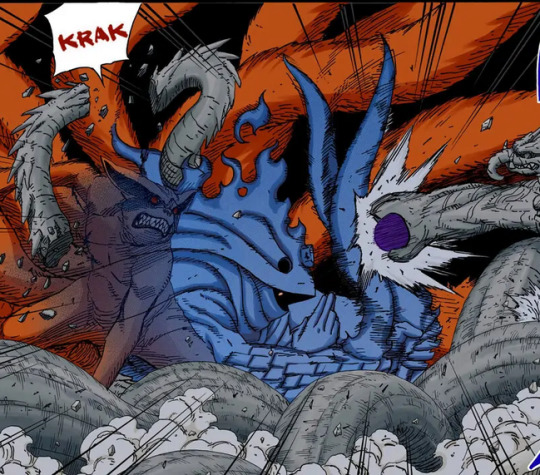
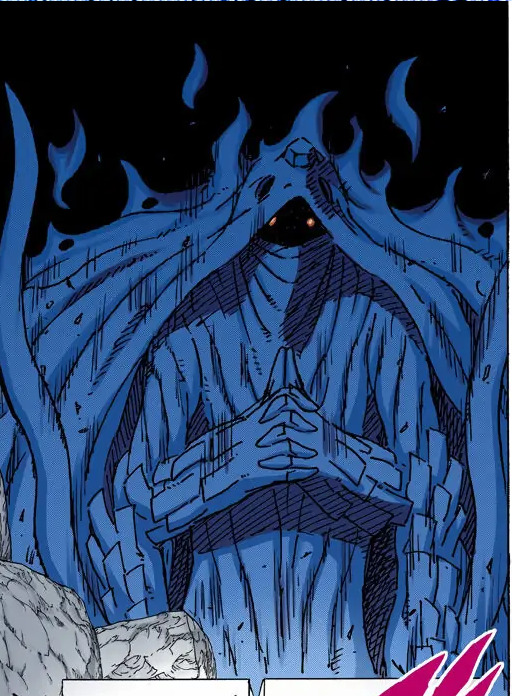
Phase 2
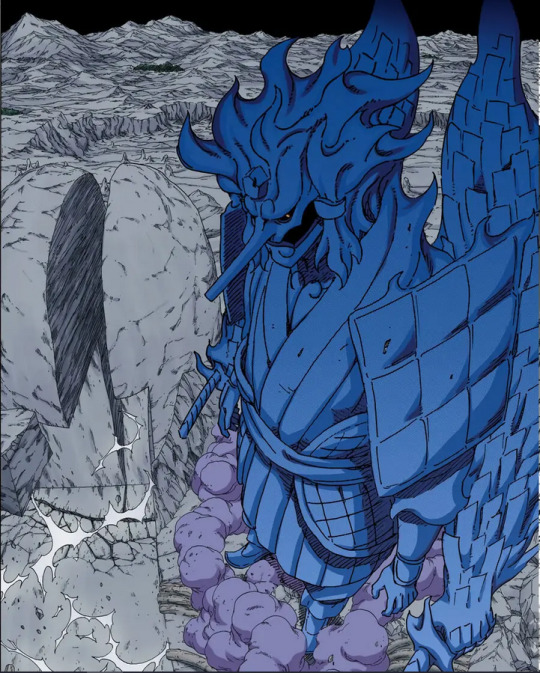
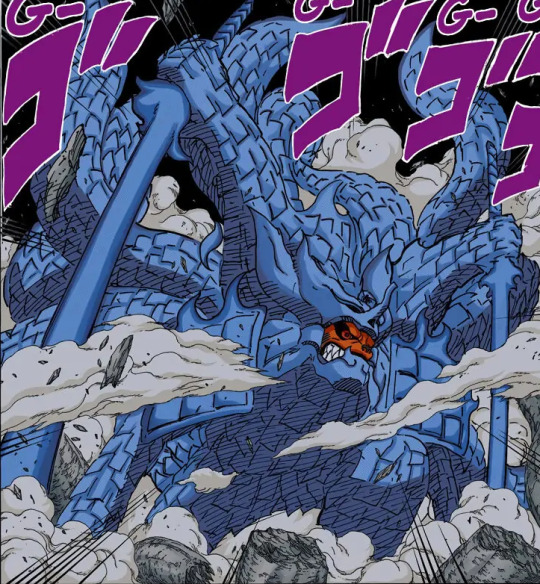
It's never explained why he does that. There is an aesthetic effort on the first phase but I didn't know if it meant something symbolically. I know that Kishimoto never draw an important character like this by chance. For instance, the two-faced susanoo represents Madara's fear for backstabbing. So I did a little research and I came with this hypothesis:
The phase 1 seems to be a reference to the Yamabushis, an order of warrior monks. They seek enlightenment through rigorous physical and spiritual training in the natural environment, particularly in mountainous regions. Look at how those monks are depicted in their war gears :


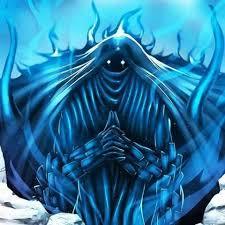
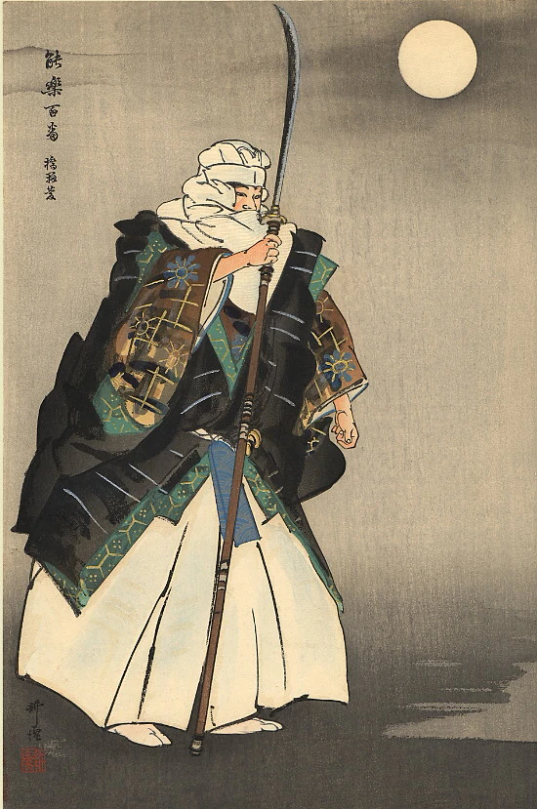
They have strong linked to Tengus, some venerate them, other stories said that arrogant priests are turning into Tengu after their death. Or those creatures kidnap priests to turn them into Tengu.
Tengus are known for their supernatural abilities, including shape-shifting, flight, and martial prowess, which align with the mystical aura surrounding Yamabushi.
Whatever the version, I found that Madara's susanoo/Tengu with his two phases, is also a strong metaphor of his unique path as an Uchiha. Similarly to the yamaguchi, Madara is a powerful warrior who went into an ascetic lifestyle, cutting link with his clan, his friend, his village to retire from civilisation in order to gain occult potent powers and ended up transforming into this fearless god of war. The size of his Susanoo manifest the full scale of his destructive anger and arrogance. He seems to have spent more time underground that in the mountain however this is the region that has been Madara's hideout for the obscure 60 years of his life after he lost at the Valley of the End. This place is called the Mountain's graveyard.

So the mythology of a Yamaguchi monk turning into a Tengu can be a metaphor of his path as a rogue shinobi becoming this almost mythical warlord. Living by the sword, belligerent and excited by the battlefield.
A last thing to note about Tengu closer to shinto tradition like the Uchiha, there is also a lot of stories of them opposing Buddhism. trying to corrupt priests, disrupt temples ect... And the Senju have a lot of affinity with Buddhist culture.
#madara#madara uchiha#tengu#susanoo#japanese mythology#japanese folklore#uchiha clan#uchiha madara#naruto#naruto shippuden#uchiha
101 notes
·
View notes
Text
of henna and hakama
𝐤𝐢 ⋆ 。 · ° ʚ 🐆 ɞ ° ‧ 。 ⋆ 𝐤𝐢
The garden smelled of cherry blossoms and jasmine. The soft wind whispered between the trees—some native to the coast of Tunisia, others carefully flown in from Japan. The setting sun kissed everything gold, and beneath it stood Y/N, draped in a rich red and gold lebsa tounsia, delicate henna curling across her hands like lace.
She stared at the arch where she and Riki would soon be wed. Two worlds tied in silk and spirit.
“You're doing that thing again,” came a familiar voice, calm and grounding. Riki appeared at her side, dressed in a formal black montsuki haori hakama, embroidered with his family crest. His hair was tied neatly, and his expression showed boyish nervousness despite his quiet poise.
“What thing?” she asked, brushing her fingers against his.
“That thing where you worry if everything’s going to go wrong when it’s already perfect.”
Y/N sighed. “I just don’t want either side to feel out of place.”
Riki gently pulled her aside, leading her down the olive tree path toward a small grove—half planted with sakura trees, half with jasmine and palm fronds. He pulled a paper from his sleeve and knelt.
“I was saving this for tonight,” he said in accented but clear Arabic, unfolding a handwritten letter. “But I want you to hear it now.”
He read slowly, reverently, pausing between each line:
"I was born on an island surrounded by quiet. You were born in a land where joy echoes like drums through the street. I used to think silence meant peace. Now, your laughter is what peace sounds like."
Y/N blinked fast. She laughed softly, covering her mouth.
“I memorized it too,” he added, switching to Japanese, this time reading the same lines in his native tongue. “Just in case your family needs translation.”
She kissed his forehead. “You’re ridiculous.”
“I’m yours,” he corrected with a smile. “Also… I learned dabke.”
“You what? You're so silly!” she laughed.
“I practiced with your cousin over video. I’m still bad. But I’ll try.”
of henna and blessings
The henna party was filled with colour, drums, women ululating, and incense swirling. Y/N sat with her hands outstretched, fingers adorned in darkening dye. She was surrounded by cousins and aunties, laughter flowing like honey.
Then, gasps rose. Riki stepped in.
It was not customary for the groom to attend, but he held a letter, not a grand gesture. He bowed slightly, carefully kneeling beside her and having a cloth so he didn’t ruin her wet henna. His presence hushed the room in curiosity.
“I just wanted to read something.”
Another note. This one is shorter.
"You’re beautiful when you speak your language and dance with your feet bare. When you call my name like it belongs in your mouth. I will learn every word, drumbeat, and step if it means standing beside you all my life."
Even the aunties were wiping their eyes now.
of kimonos and kaftans
The morning sun broke over a ksar in the Tunisian desert, its ancient arches now lined with sakura garlands. Guests arrived dressed in bright foutas, kaftans, and kimono. Riki’s family wore traditional Japanese wedding garments. Your father wore a jebba, and your mother and sisters draped in silk.
The ceremony began with a Shinto ritual, the san-san-kudo. Three cups, three sips each, sharing sake beneath the carved olivewood gate.
Then, the drums began. Tunisian mezuoed music echoed as the couple wore traditional Tunisian attire. Riki looked regal in his embroidered vest and sash, slightly unsure but smiling. Y/N's hand never left his.
Dancers spun. Family ululated. The air smelled of incense and jasmine water.
They exchanged vows in both languages—her in Arabic, him in Japanese, both soft-spoken but unshakably sure.
of two moons, one dance
The stars watched their first dance from high above.
The music began: a carefully mixed track of soft strings woven into the upbeat rhythm of Tunisian drums. They twirled, laughed, and stepped wrong and right. Riki tried a dabke step, and everyone cheered—especially when he stumbled and laughed through it.
“Let’s call it dabke-onna,” he joked, mixing the word with onna-odori, a Japanese dance. Y/N threw her head back, laughing.
Later, under a canopy of cherry blossoms and jasmine garlands, they stole away.
Riki pulled a box from beneath their table. Inside were dozens of tiny notes—some on rice paper, others in folded Arabic calligraphy.
“What’s this?” you asked.
“Letters I wrote every week since we started planning. Every time I learned something new about your culture—or about you.”
You read the first:
"I tried kaak warka today. I thought it was too sweet. Then I had a second one. You win."
Another:
"Your mother calls me waldi now. It means 'my son,' right? I cried after I left your house that night."
Tears brimmed in her eyes. She looked at him, overcome.
She kissed his hand.
Then she pulled a letter from her sleeve and handed it to him.
On it, in hiragana and elegant Arabic calligraphy, was one phrase:
“My heart is your home.”
of the end.
Two traditions. One love. Forever woven in jasmine and cherry blossom.
HAPPY BIRTHDAY @shxhdsstuff!! I did my best researching both cultures of Tunisian and Japanese. I tried my best. This is my birthday gift to you, I hope we'll meet each other soon! If it doesn't make sense I'll fix it up afterwards!!
#hazelira#shxhdsstuff#enhypen#engene#pov#kpop fanfic#x yn#enhypen oneshots#enhypen comfort#enhypen fluff#enhypen ni ki#enhypen riki#enhypen nishimura riki#ni ki oneshots#ni ki comfort#ni ki fluff#happy birthday#japanese#tunisian
30 notes
·
View notes
Text
Okay, but why the "Kannabi" Bridge? I mean, why is this called that? Turns out, this is an amazing and very beautiful metaphor.
Kakashi Gaiden analysis. Kannabi — the bridge between two worlds
I will look at this from the side of Shinto culture (based on the materials that I could find, feel free to correct me if you know more about this) and from the side of Kakashi and Obito's storylines.
Contents | cultural code · significance for the plot structure · the idea itself (this one is really important!)
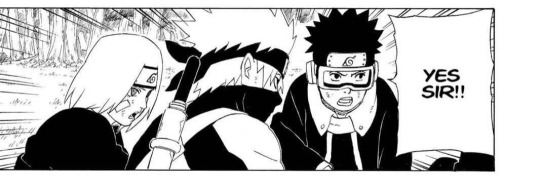
Cultural code
In Shinto culture, it is not customary to divide the world into human and sacred, especially into divine and demonic principles — everything exists in harmony with each other, in a single system.
Kannabi (神奈備) refers to a region that is a shintai (repositories in which kami reside) itself, or hosts a kami. In fact, Kannabi is a place of connection between the human and the spiritual. Usually these are mountains, rivers, and forests that stand out for their beauty. These are such accumulations of natural energy, so sacred that their presence requires observance of a certain rite. So, if in relatively modern times be present next to the blossoming sakura, picnics in picturesque mountains and the like has normalized in Japanese culture, then in ancient times people did not dare to disturb mountains or groves with their presence. In such places, people performed rituals of worship to the deity, wrestling matches, divination, sacred dances, offerings, etc. The territory of the kami did not completely coincide with the territory of worship to them, people still tried to move away from the center of the sacred place so as not to bother their deity. To mark the border of entry into Kannabi, symbolic gates were installed — most often in the form of torii.
examples of kannabi in real life. Mount Fuji and Nachi Falls. [ as I understand, shintai and kannabi are synonymous concepts, but kannabi is broader in meaning. ]

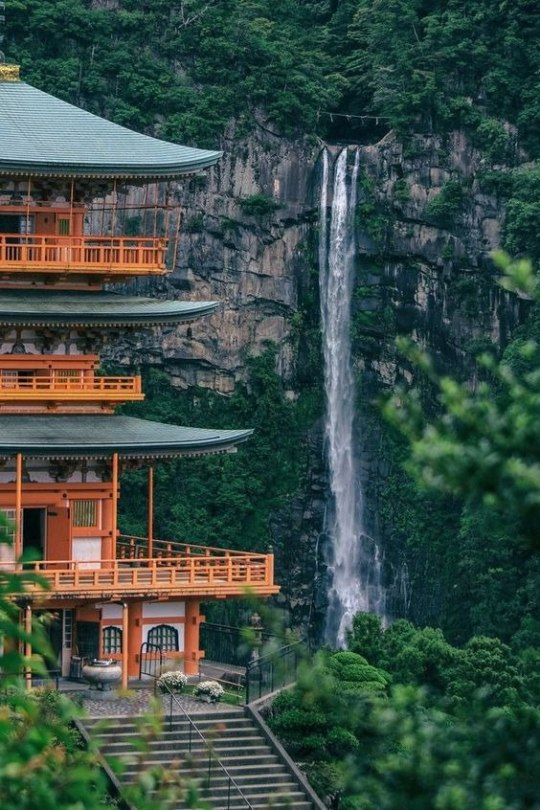
It's all about how important the term is in a cultural context. A place of divine power that cannot be desecrated. From here, the Kannabi Bridge and the surrounding area can also be considered endowed with divine energy — and here the most interesting thing begins.
Significance for the plot structure
Now about the scenario composition. In general, the Battle of Kannabi, as the event itself in Kakashi and Obito's storylines, according to Joseph Campbell's «hero's journey», is a stage of transition between worlds. That's what the symbolism of the place also works for. This is the moment when the hero assumes responsibility for the beliefs he carries and their consequences, and literally or symbolically crosses the threshold between the safe and familiar world to the dangerous and unknown one, embarks on the path of reflection and prepares to meet the unconscious.

Thus, briefly speaking, Kakashi finds the strength to resolve his internal conflict in favor of his father's attitudes about the value of each Shinobi, and Obito sacrifices himself, protecting his loved ones and defending his ideals. Then their paths got separate so that each one could face with the unknown by himself.
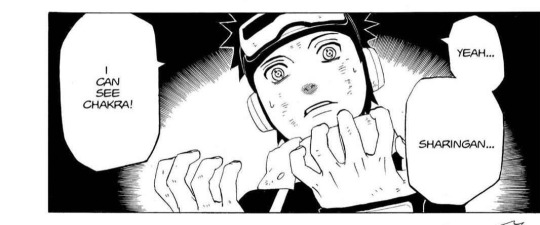
In the context of the monomyph model, this is how the beginning of the initiation stage is demonstrated (i.e., the transition from one state to another, which is accompanied by some kind of ritual). Since Kannabi in culture is the boundary between the human and the divine, it can be concluded that this very transition is shown almost literally, thanks to the sharingan awakening and the broken tanto. This is the first turning point in history, structurally coinciding with the end of the first act.
The idea itself
And what do we see in general? In the battle of Kannabi, the religious Shinto subtext is vividly read. For the battle in a sacred place, the moral positive change of the hero (Kakashi) or his original courage (Obito) and a certain sacrifice (Kakashi's eye), the deities give a reward: the power of sharingan, which helps them save Rin, which is shared between Obito and Kakashi and in the future generally serves as a direct demonstration of the spiritual connection between them. At the same time, for the desecration of a sacred place (the goal of the mission was to blow up a bridge), heroes are punished: from this point of view, Obito's death is a certain sacrifice for the damage inflicted on the deity.

There is also information that the name of the bridge - Kannabi-kyo (神無毘橋) - can also be interpreted as «A bridge where the gods won't help». idk if it's true, but sounds cool.
Moreover, the very name of Obito's mangekyo — Kamui (神威) — literally translates as «The Power of Gods». Perhaps it is based on the mentioned concept of the place where Kakashi and Obito received the power of sharingan. And maybe that's why they call the technique the same way: because they treat it rather with such a religious meaning.
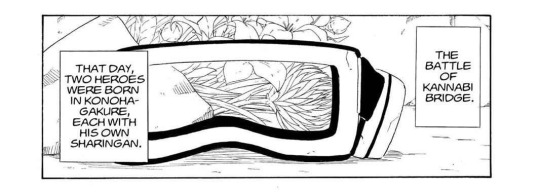
and thanks for reading to the end ♡
#honestly this is one of my favourite things in gaiden so complex and interesting and ughhh–#naruto#naruto shippuden#team minato#kakashi hatake#obito uchiha#rin nohara
207 notes
·
View notes
Text
Toman and Buddhism + Tenjiku and Taoism
Another post to cover references in Tokyo Revengers!
This time, I'll be covering the links to two religions to be found in two gangs in the series, reference by reference, with the according explanation of each.
Some of these may be already known, I know one of them sure is (the whole buddhist manji confusion thing yeah yeah) but still, for the sake of a tidy compilation and of providing more detail, I'll go through them too. Some others are a lot less noticed, like Tenjiku's lean towards Tao, so it'll be best to lay down eeeeeeverything I've caught during my time enjoying this series. Plus, I'm pretty excited to get some of those less-known facts out here!!
Warning though, it's lengthy.
Let's start with Tokyo Manji Gang:
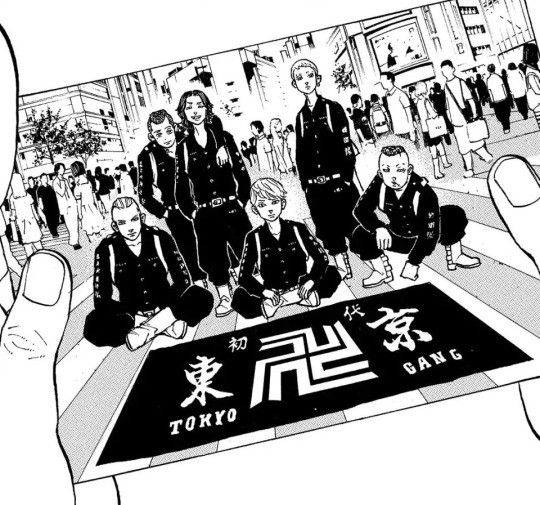
- Firstly, the gang's name and how it's written.
Despite Mikey suggesting the name as a short form of Tokyo Manjiro Gang, putting himself front and center, the kanji that ended up forming the name of Tokyo Manji Gang show that it went in a different direction of meaning. The manji used for the middle part ended up not being the same one from the name Manjiro, but a manji written as 卍. Aloud it's read the same way (many, many, many kanji are homophones), but has a different meaning.
卍 (manji) is an extremely common buddhist symbol (not even limited to japanese buddhism, but in hinduism and other aligned east-asian religions too), which represents the path of Buddha and the endless cycle of rebirth through samsara; the pursuit of leading a more spiritually balanced existence until the soul can reach enlightenment. In other words, it's nothing but deeply buddhist.
(To answer a common question around it: can it be called a swastika? Yes. The symbol in general, with each of the million variations that have popped up in different cultures, can be called a swastika as a broad term. There are a fuckton of swastikas. They mean a fuckton of different things. The tilt and the direction in which this one "spins" makes it different from other swastikas though, and it's always best to be precise and call this one manji.)
Moving on,
- Reunion spot.


The Musashi Shrine (based, but not exactly taken from any of the real-life shrines and temples of similar name in Tokyo, as far as I know) is a shinto-buddhist temple. And, apparently, a place where the founders hung out from time to time, but I'll add to that later!!
It's cute to me that the Toman members seem to use the temple very respectfully. They always meet in it at night waaay after it's closed (daytime meetings have always taken place in different locations, never the temple during visiting hours), they've never once set foot even near the oratory/sanctum/other buildings, never been seen bringing the motorcycles anywhere they shouldn't, and the one time a character was seen using the public temizuya (the little stone fountain where visitors purify their hands and mouth), he was proper about it in terms of pouring water into his hand to rinse his mouth with, not getting the ladle or the rest of the water dirty, as one should always do.
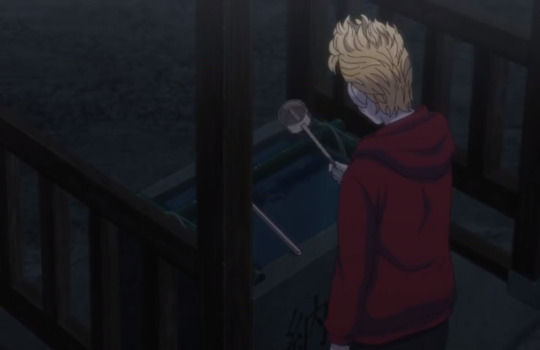
A fun fact: in Google Maps, buddhist temples are marked with the manji symbol!
- Gang's manifesto.

Embroidered on the chest of the gang uniform, you can see the text 天上天下唯我独尊 ("Above the earth and below the heavens, I alone shall be honored"), which is the gang's manifesto or motto. Sounds just like something Mikey would choose, yeah.
That phrase is also of buddhist origin; famously, the words spoken by Buddha Gautama Siddharta (bear in mind that buddhism isn't a religion with one god or anything like that, anyone enlightened can become a Buddha and many figures have been granted that status, but Gautama is the first and main one, the creator of the doctrine) when he was born. To be honest, this is very much interpretative, but I've come to get the impression that it's not so much a power or ego statement, but rather an expression of cultivating and honoring yourself…? It's absolutely up to personal reading and I'm absolutely not an expert. But those are certainly THE Buddha's words.
- Ceremonial sash.

Another part of their uniform that bears a slight reference: the sash worn by the commander, vice-commander, captains and vice-captains during important fights.
These are tasuki, sashes originally worn by shinto-buddhist priests during ceremonies, in order to keep long sleeves and such in place. However, eventually, they also began being worn by samurai and all sorts of warriors, 'cause of their convenience. In modern times, they even started being used by just about anybody who wears traditional clothing but also does manual work and needs the sleeves out of the way. So it can be concluded that, over time, they stopped being strongly linked to religious practicers. In fact, even biker gangs in general ended up adopting the use of tasuki! Not for their religious origins, but for the warrior part; a bōsōzoku gang member wearing one would look very prepared and determined for a fight.
That's why overall, Tokyo Manji Gang having them is only a relative reference; they could be paying homage to their reference religion, as they could be only honoring gang traditions.
- Additional notes about the leader.
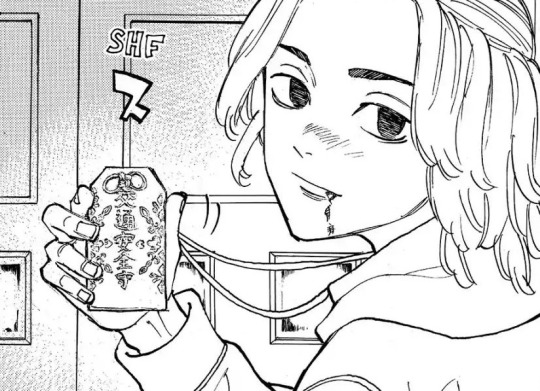
I feel it's important to add up all these little factors of Mikey's choosing, with other little details about him as a person that kinda make it all make sense.
If I say "Mikey seems to be religious, to an extent", I understand this can carry a bunch of tricky connotations. Japanese religion isn't exercised the same way it is in other places, someone being religious SURE AS HECK doesn't mean the same things it means in the christian west. Shinto-buddhism is so commonplace in Japan, most people partake in all kinds of religious practices without even thinking of them as strictly religious, such as new year's celebrations, casual prayer during shrine visits, purchasing and giving charms and such. Religion is integrated in life in a lot of extremely chill ways.
And we can observe a lot of things about Mikey that put him quite above the average in terms of his relationship with local tradition and religion. His house is a huge traditional-style family home, his family is hinted to be active in religious practice (remember Emma's appearances during the Christmas Showdown arc? How she mentioned that their family does a lot of temple visits, and even she considered it weird at that time of the year?), he's much more prone to wearing traditional clothing than his peers, his motif in extra clothing designs is the lion-dog (temple guardians; statues of these can often be found in them), his personal beliefs around death and relationship to the dead run deeper than others' to the point they find him disturbing when he talks about Shinichiro or Baji still being with him... many little things that aren't that deep on their own, of course, but when added up they paint a pretty coherent picture of the guy.
And so, it does make a lot of sense that, even from childhood, a temple was a regular place for Mikey to hang out with his friends, leading to the birth of Toman in one. And it makes a lot of sense that he made all those little choices about the way the gang would be styled. In my opinion, it's likely that those things just all came natural to him because they're a part of his background and worldview. Of course, how actively religious he is, how much he believes in the things he happens to know and how much exactly he might know about buddhism are all up to headcanoning and interpretation. Personally, I'm just a roleplayer that takes it as a relevant part of his character.
- Following a Buddha?
A little out-of-TR-universe element that I love to bring up, 'cause it's just hilarious and cool as hell, is the creation of this statue:
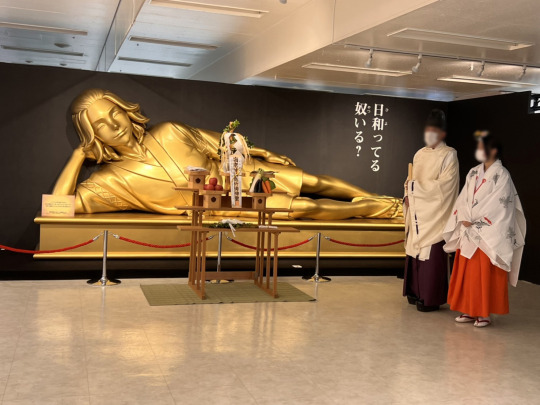
This part of the 2022 Tokyo Revengers exhibition straight up imitates the famous Reclining Buddha in the Wat Pho temple, Thailand.

The ENORMOUS statue depicts the moment Buddha reaches nirvana, and his enlightened soul is at rest. The golden Mikey statue that imitates it very much intentionally likens him to a Buddha; funny to note that the exhibition staff even prayed to the statue, as you can read in the tweet itself.
What does this mean about Mikey's character? Well, this isn't within text in Tokyo Revengers, just a little outside factor, so I wouldn't take it too literally or too seriously, but it's interesting nonetheless. Personally, I see it as a hint that Mikey was supposed to be on his own little quest to enlightenment, or had the potential to be. Grappling with morality without having a natural sense of what's right, wrong, too much or enough is a major thing with his character. I can also imagine it might just be meant to represent the godlike view others have of him, the guidance they sought from him. Take it as you will!
The important thing is just that it exists, to confirm that there is an intentional connection of some type between the Buddha and Mikey.
Thaaaaat concludes the Toman and Buddhism section of this post.
Whew!! That was a whole lot.
The Tenjiku and Taoism section coming now is shorter, but I'm sure it contains interesting and less-known things (at least, I've never seen anybody talk about these)!
So let's see, Tao references in Tenjiku:

- Gang name.
Tenjiku is a now-obsolete word that translated directly to "heaven", while simultaneously being the japanese word for the country India (as taken from the chinese pronunciation, Tianzhu).
In modern times, it can be found mostly in ancient literature, the most prominent example being Journey to the West. Given that Kakucho and Izana mentioned this book and seemed to have knowledge of it as kids, we can conclude that's where they got the name of their gang from.
Why would they use the word for India to name their kingdom? What does this have to do with Tao? I'll get into that properly now:
- Kakucho, Izana & Journey to the West.

Journey to the West is one of the four great chinese classic novels (along with Romance of the Three Kingdoms, Outlaws of the Marsh, and Dream of the Red Chamber) which are enormous, ENORMOUS influences on east-asian literature and fiction in general. Journey to the West, itself, is considered the most popular east-asian literary work overall; of course, being super well-known in Japan, too. (To give my favorite funny example of just how omnipresent it is, y'know Dragon Ball? Hit anime series Dragon Ball? Unabashedly based on Journey to the West, which was to thank for most of its initial local popularity.)
It's the story of the buddhist monk Tang Sanzang, who travels to Tenjiku, to India, to that certain heavenly kingdom, to obtain sacred texts for Buddha Gautama Siddharta (the guy I described as THE Buddha in the Tokyo Manji Gang section above). The quest doubles as a search and exercise of enlightenment, as Tang Sanzang is aided by three protectors that are atoning for their sins and learning from him. The main guardian and arguably the true protagonist of the book is Sun Wukong, the Monkey King, a fighter "so strong he could carry a mountain on each shoulder, and still dash as fast as a meteor". It's a huge, epic, 100-chapter monster of a book, in which each chapter is already a fantastic and entertaining anecdote about the characters or what happens in their travels, but also a long spiritual journey that pretty much serves to subtly teach the principles of Tao (term that can be translated to "the path", chinese religion and philosophy).
A tangent: let me just show you how large it is (and why I haven't been able to finish it, 'cause I cannot take this brick of a book anywhere lmaoooo).

(Cover says Journey to the West: The Adventures of the Monkey King. It's in spanish.)
My guess is that Izana and Kakucho studied about it or read some chapters in school, 'cause dang, there's no way they read all of this at that age?!?! BUT ANYWAY.
While there's obviously quite some buddhist influence in the story, most of what it works with throughout is rooted in chinese folklore and Taoism. The edition of the book I have even begins with extensive notes and introductory explanations about Tao, as its themes of harmony with the universe, self-cultivation, internal alchemy, its main ethics and values, etc etc etc are the basis from which the book is built up. The characters very actively engage with Tao. Sun Wukong is an ardent student of Tao who obtains a bunch of powers through it, for one.
I've gone into this much into detail because Kakucho and Izana make it pretty explicit that, to them, Izana is like monk Tang Sanzang leading to Tenjiku, and Kakucho is like his guardian of unmatched strength, Sun Wukong.
In the end of Journey to the West, it's both Tang Sanzang and Sun Wukong that accomplish their goal and also obtain enlightenment, finally ascending to buddhahood. Had Izana and Kakucho's journey with Tenjiku reached their original destination (not "to become a criminal syndicate that controls Japan" but "to build a kingdom where everyone without a home could exist"), had it been like Tang Sanzang and Sun Wukong's pilgrimage… they would've learned true balance and they would've found the necessary enlightenment.
Again, I find this little connection with characters that could've been on a quest towards buddhahood, but as far as things went in the main TR timelines, all failed.
- Uniform & logo.
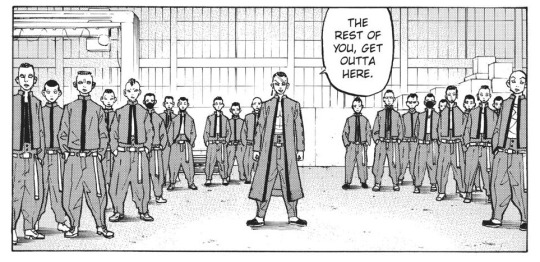
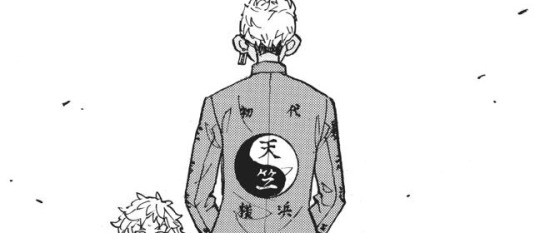
Finally, something lighter and quicker to add, haha.
There are symbols and references that are so so so widespread that they become more of an aesthetic detail than a symbol with meaning, in the eyes of the general public. The yin-yang is one of those symbols that just… appears in a lot of places, fashionably, and one kinda gets used to seeing it without thinking much about it. Sometimes it's not meant to stand for much more than a decorative detail, yes, that definitely happens, but sometimes it's very much a thoughtful choice. With Tenjiku, given its connection to Taoism, I'm gonna treat the yin-yang as a meaningful choice.
So! On the back of the uniform we have a yin-yang, Taoist symbol that represents the balance of the two complementary and opposing forces of the universe (note: it's not a good vs evil type of thing, as tends to happen with western black-white dualism, but rather… the fact that reality needs to be composed of push and pull to get anywhere, hard and soft things with their own function, sun and shade. A common comparison is how a mountain will have a sunny side and a shady side when looked at in a certain moment, but the sun and shade will switch over at another time of day, in a needed cycle). Other features of the uniform are a mao collar instead of a more common style for gang jackets, and an intense red color, the main auspicious and prosperous color in chinese culture. These last two little features could easily be coincidental, but when paired with the yin-yang, I feel like it's intended to lean towards chinese aesthetics.
And with that,
I end this reference post!
Did you learn anything you didn't know? Did you enjoy learning it? Any thoughts? I LOVE TO TALK ABOUT THESE THINGS, SO FEEL FREE TO DROP BY MY ASKBOX with any comments or questions or such!!
#tokyo revengers#tokyo revengers meta#tokyo manji gang#toman#tenjiku#kurokawa izana#sano manjiro#izana kurokawa#manjiro sano#mikey#kakucho#thoughts and talk and so#tokyo rev#wanted to write this one forever#just never quite got around to it
211 notes
·
View notes
Text
In my recent ventures of fanfic writing, I've come to notice how little information we actually have on the Gojo clan. So, being the neurodivergent fucker I am, I have decided to do a bit of my own research to try piece together a semi-coherent thesis on them— as a fun little exercise. Also, most of this is headcanon. I also wrote this on one and a half hours of sleep and a shitton of coffee.
-> Some needed exposition (The Blah Blah).
The Gojo Clan are descendents of Sugawara no Michizane, one of Japan's Three Great Onryō (known as "vengeful spirits" in english). Sugawara (August 1, 845 – March 26, 903) was a scholar, poet, and politician of the Heian period. He excelled particularly in waka and kanshi poetry, and is also seen as the Shinto god of learning, Tenman-Tenjin.
While Gojo Satoru is referred to as the one-man act of the Gojo clan, it's made clear that there are other members within said clan.
Gege has gone on record to say that Satoru would often sneak out or slip away as a child to roam around the city. He said this in the 33 questions he answered about Satoru.
Gege (also through 33 questions about Satoru) says that Satoru was spoiled rotten as child, while simultaneously being isolated from most childhood experiences. He also states that his parents were forced to relinquish him during his early years due to their abilities as sorcerers being subpar relative to the young heir. He also said that Satoru was mostly in Tokyo for training as a kid.
The Six Eyes are said to be a hereditary trait, though it's not a cursed technique like Blood Manipulation or the Ten Shadows. But unlike the other two clans, the Gojo clan is kinda useless without their human embodiment of a weapon— the Six Eyes are technically not needed for a Gojo sorcerer to use limitless, but without SE a Limitless user cannot harness their full potential. Ie, they'd be kinda average. But again, CTs aren't exclusively hereditary so there's a good chance that a Gojo clan member could get a powerful CT. I'd even go as far as to say that the Gojo clan chooses a head who was born with with the strongest CT to maintain appearances.
All of the clans are pretty traditional, but we can see that the Gojo clan is a lot more lenient in their traditionalism. I'm saying this because, if it were up to the Zen'in or Kamo clans, Yuuta wouldn't have become clan head. The other two seem hellbent on traditionalism while the Gojo clan (from what little we've seen) seems more welcoming of change. I think this is partly due to the the way the Six Eyes are inherited: there can be no two SE and the bearer is bound to the same mortality as the people around them. Another thing to keep in mind is that the SE manifests once in a few centuries; for the SE and Limitless to manifest together is a miracle in itself. Therefore, the Gojo Clan can't afford to be rigid/petty in their structural hierarchy.
The Gojo clan is situated in Kyoto, AKA the cultural capital of Japan. This'll be important later.
Buddhism is a core theme in Jujutsu Kaisen (I'mma be fr, the last two facts were added last minute cause I lowkey forgot to write them in 😭)
★ Piecing it together (The Blah Blah, but Kovi has fun) .
As established in (8), Jujutsu Kaisen is a world that is heavily based on Buddhism. Not just that, but the world of Jujutsu itself borrows from many aspects of Buddhism (Dukha, Mudra, Bodhi, The Eightfold path, etc. etc.) So it wouldn't be much of a surprise if the Big Three™️were to adhere to buddhist principles/values, to the point where it crosses into dogmatism. I'm inclined to believe that the Gojo clan are the ones who manage maintain their facade of pragmatism the best. This is mostly due to how the other two clans seem...trigger happy. K(enjaku)amo Norotoshi has already tarnished the name of the Kamo clan, and the Zen'in clan are, uh. Not the nicest bunch. That isn't to say that the Gojo clan are any better than the other two though. Because stated in (5), the SE and Limitless are a hereditary technique. Ie, they could be inherited by men or by women. And considering the rampant misogyny in the Jujutsu world, I feel like they'd just pass her off as a man. This isn't a stretch btw, it was an actual practice in medieval Japan. Would make sense for the old geezers to retain this practice, especially in case of a heir who's supposed to be ✨enlightened✨. But this seems contradictory, no? I literally just said in (6) that, of the big three clans, the Gojo is most lenient in it's rules. Which— yeah. Between the three clans, they are the most lenient. Especially taking into consideration (4). I feel like they'd be less abusive physically, resorting to verbal reprimand. Kinda like that one aunt at a family gathering who's always shitting on your sister's looks, even though she's the farthest thing from a sight for sore eyes (don't ask). Speaking of! Referencing what I said in (1) & (7), I think that the Gojo clan (and the Kamo clan, which is also in Kyoto) would be very particular about their cultural education. I mean, think about it; if you're part of an ancient clan, living in the cultural capital, while having an ancestor who was a poet...wouldn't you also want to be educated in the arts? Yes, this is an excuse for me to make Gojo wax poetic; no, I don't wanna hear about it. Also, he's Asian. Asians don't play about their culture. Oh! And bringing in (3), I wanna add that the heirs are probably given rigorous training to be worthy of their position as head. Doesn't matter if they're special or not. Satoru probably skipped classes to run around the city lol. Also, (4) also explains a lot on why he resents the higher ups. They basically took away all he had as a child, giving him material pleasures while withholding emotional affection. They probably used the whole 'no attachment' belief as an excuse. Also, going to (5) I'd wager that Gojo clan heads are more ceremonial than anything, the clan governance being handled mostly by the older elders. Of course our blue-eyed king is an exception to this, as are the other SE users.
Aaand, that's wrap. I've gotten that outta my system, so hurrah. Now I'mma go eat some unbelievably unhealthy shit
#jujutsu kaisen#jjk#gojo satoru#gojo clan#geez louise#This took longer than I thought#headcanon#or something#k byeee#my english teacher would be proud lmao#OOS extras
45 notes
·
View notes
Text
Wuejeheheheh People ln Reddit started posting the apparent newcomers y’all!
Take a guess at what is under the cut
FIRST UP
The girl that’s trowing hands in the cd cover
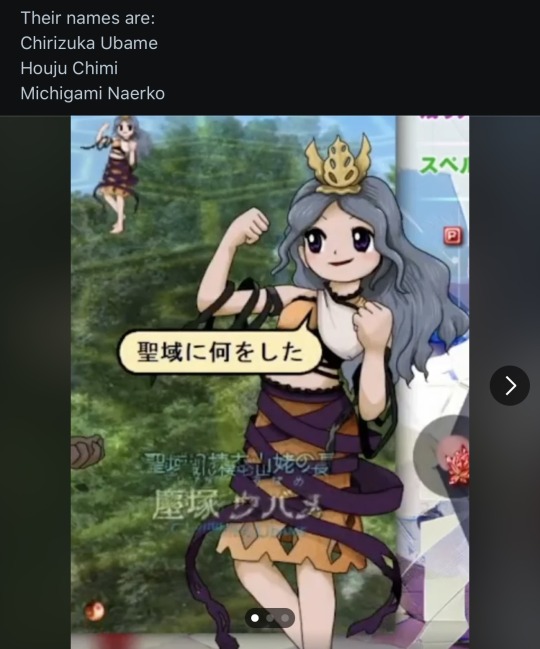
“Chirizuka Ubame”
Some people say she’s also a type of hermit/Yamamba like Sakata, has a similar attire that of her and Biten, so it kinda fits, seems to be a shrine guardian too, headgear.
NEXT, NUE’S ALTERNATIVE???

“Houjuu Chimi”
I have nothing on her, probably design wise is a chimera of sorts (Like Nue). Reminds me of a Parrot lol.
FINALLY, EGYPTIAN TOUHOU???

“Michigami Naerko”
Interesting everything… people say she’s inspired in deities of roads and paths (both Shinto and Egyptian) which is awesome! Her design reminds me a bit of Cleopatra, some people say she could be meant to be a Sphinx.
Also, if I’m not mistaken (I’m probable to be) those are burial items? Her thighs have “OXOXOX” written, Iunno, and her headgear reminds me of a parent and a child, which I think is only me.
Also pyramid. Like, in the back.
Someone also “leaked” I guess, the ost until now, I don’t know if it’s legit or no, but check it out if you wanna:
#touhou#touhou project#touhou 20#fossilized wonders#Touhou Fossilized Wonders#spoilers#touhou 20 spoiler#s#Chirizuka Ubame#Houju Chimi#Michigami Naerko
28 notes
·
View notes
Text
Oshi no Ko's Angel of Light: Kamiki Hikaru
So, I wrote a review of Oshi no Ko previously, just not on this blog. I talked there about the meaning of Hoshino Ai as a name (it's literally hoshi no eye, Ai spelled in katakana to reinforce that it's a loanword, meaning starry eye, and of course, eye/ai is a homonym for love) and how Oshi no Ko uses wordplay and puns to introduce its themes.
Naturally, I wanted to talk about the other parent, whose name is just as significant.
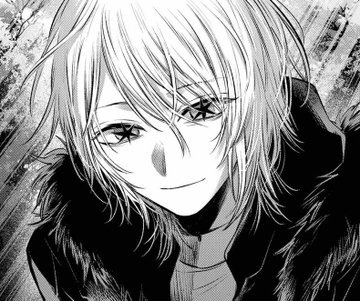
Kamiki Hikaru is literally "god of light/shining god." Well, okay, sort of. It's technically "kami of light," and kami doesn't translate super well into English. It's often referred to as a god in Shintoism, but it's not quite the western perception of a god. Spirit is another popular translation.
Of course, this references the supernatural themes of the story, as well as Hikaru's role. See, "angel of light" is what the Christian Bible calls Lucifer, the Christian devil. Pretty fitting for Hikaru's role in the story as the main villain.
But wait! There's more! Lucifer itself, as a name, refers to the planet Venus, known as the morning star. Which, of course, is the "star" we see in the story associated with Ai.

(Yes, the story is very much using distinctly Christian allusions alongside Shinto ones.)
Hikaru, like Lucifer, is known to, well, want everything for himself. That doesn't mean he wants all the worship of the world like Lucifer literally did according to mythology. No, instead it's far more insidious but no less disturbing: he sees himself as entitled to dictate how the world runs. He decides whose life is worth living, and makes others pay for mistakes of people they don't even know. He's playing God, in other words--exactly what Lucifer did to fall from heaven in Christian mythology (it's not actually super biblical hence why I'm using "mythology").
Lucifer is also called "Satan" obviously, which literally means "accuser" in Hebrew. That's kind of the perfect summary for what Hikaru sees himself as: he's visiting his hatred of an abuser he has every right to hate on everyone and everything that remotely reminds him of her.
The thing is, as said above, Hikaru does have the right to hate Airi, just like Aqua has the right to hate him. But following the path of revenge is Not The Way.
So, is Hikaru Satan?
No. He's a person.
The Path To Hikaru
Hikaru is not all that different from the other characters we know and love--Ai, Ruby, Kana, Akane, and especially Aqua. Fitting since they're all idols of sorts (yes, Akasaka is constantly using religious references to add social commentary to the idea of an "idol" as a false god/object of worship). They're also all actors.
Hikaru is what Aqua risks becoming. No, seriously. Hikaru was traumatized as a child via rape that led to the creation of a life.
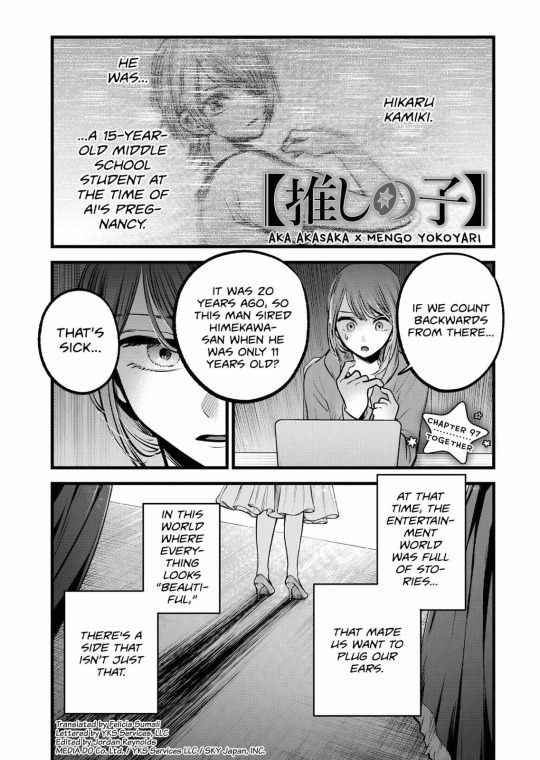
As a result he's pretty anti-life as a whole, and especially anti-woman. He's constantly seeking revenge on women, hence his murder-happy spree. The problem is that he's not seeing these women as individuals: he sees everyone and everything as a representation of Airi, the person who assaulted him.
Also, society as a whole's attitude towards male victims of sexual assault, especially male victims of attractive women, means that Hikaru would not be seen as a victim. One of OnK's major themes is how messed up society is and how it dehumanizes people via fitting them into roles, and this is a perfect example of the harm that can come from it. Hikaru would be seen as a boy, and all boys clearly want sex. A famous actress slept with him? Lucky him! Even though this never came out publicly, Hikaru absolutely knew this was the case and it certainly plays a role in his grudge against the world.
Even though Airi is dead (probably as a result of him provoking her husband by revealing that he wasn't the father), he still isn't satisfied. No, Airi is still everywhere. Killing the perpetrator, making them pay, did not erase his trauma.

If Aqua kills Hikaru, his trauma will likewise not be erased. Not his trauma as Gorou, not his trauma as Aqua. Hikaru's death will fix absolutely nothing in his life besides stopping more murders, but there are ways to do that that, y'know, don't involve killing. If Aqua kills Hikaru, he will lose the best part of Gorou (valuing life) and the best part of Aqua (the future Ai wanted for him, a future with Kana and Ruby).
Aqua, You are Your Father
Aqua, you are your father. It's almost like the entire series has been trying to give you this message and you keep ignoring it. (By the way, because I know I'm going to get asks about this, I am NOT saying Aqua and Hikaru are moral equivalents. Not at all. I'm just saying that Aqua is walking a path that will end with him being just like Hikaru if he doesn't get shoved off said path.)
From being the violent stalker who attacks someone who has never felt loved in his first acting job after Ai's death to scenes like this:
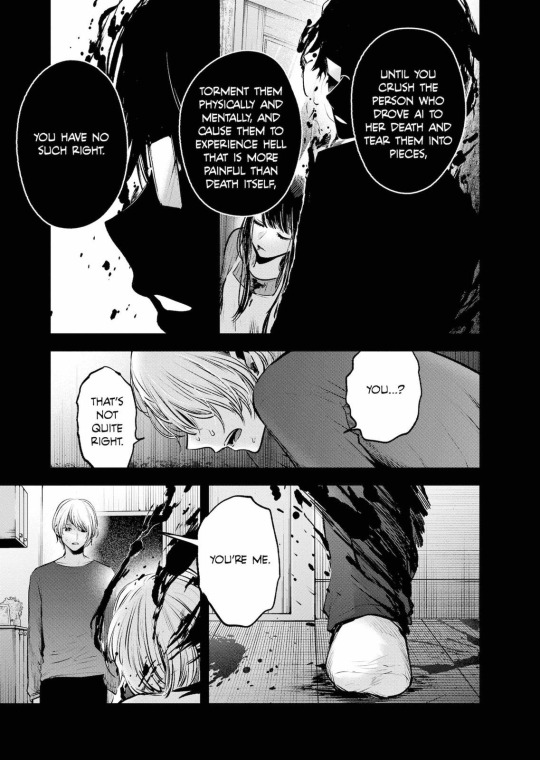
The story is asking Aqua to take a good long look at himself, and he's trying desperately to avoid doing this. Why? Because he's also playing God, same as his father, same as Satan in Christianity. He thinks he is responsible for everything; a natural, childish attitude that people grow out of as they age.
Of course, Aqua is not nearly as toxic in this as Hikaru--he's not attacking innocent people--but the root of this is still a belief that he somehow controls what happens, when he doesn't. He doesn't at all.
Aqua, too, is just a person.
But Aqua struggles to understand what it means to be a person, to be Hoshino Aquamarine.
He struggles to see other people as people, too. This ranges from sabotaging Ruby's auditions to how he treats Akane to his protecting Kana without considering what she wants. It's been brought up multiple times in the story so far:

Aqua also fundamentally does not see Ai as a human being, either. Unlike Ruby, who calls Ai "Mama," Aqua only ever calls her "Ai," her persona. Aqua and Ai are foils to Kana and her own mother, in that Kana's mom lived through Kana only to abandon her, and Aqua is living through his mom... but ignoring what she would actually want.
(Ruby isn't flawless or perfectly healthy, and the story certainly doesn't frame them as good twin bad twin, but Ruby's overall worldview is absolutely more in line with what the story wants to endorse.) That's why we have lines like this, where Ruby reveals that she has a healthier view of their mother than Aqua does. She knows Ai was flawed.
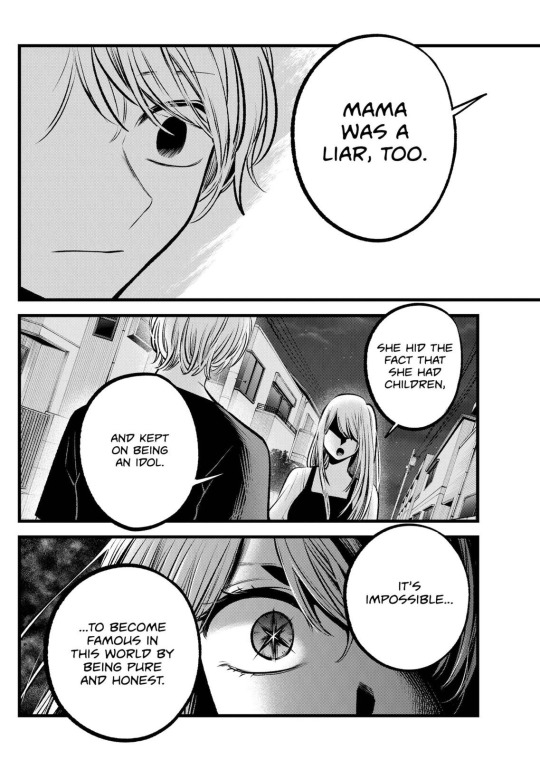
This is extra notable because he has 0 problems calling Hikaru his father. It's almost like Aqua is drowning in self-hatred, in feeling unloved, in the idea that he brings bad luck just by existing.
He'll call out Ruby for her negative traits, but Aqua thinks he deserves them. Aqua dehumanizes himself, the same way he dehumanizes Ai, and he has to see both his mother and himself people before he can step off this path.
Essentially, what he tells Ruby here is exactly what he needs to realize, but he has not done so.
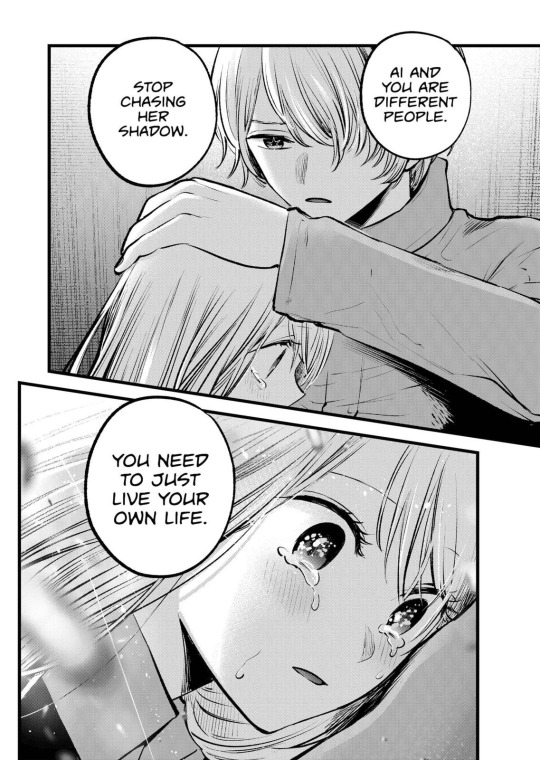
The root of Aqua's God complex is that he cannot move past his trauma. It's actually psychologically realistic that a child who experienced such an event would be stuck in a childish mindset wherein they feel guilt for not being able to save their mother.
But it's not just Ai that Aqua couldn't save. It's Sarina, too. She is the one who introduced him to Ai, after all. He didn't move on from her death in his past life, either, which can probably be traced back to his own tragic birth circumstances--the idea that he only brings death, because his mother died giving birth to him. Gorou even states that he became a doctor to help people like his mother, but the point is also that he wanted to bring life, not death.
Except, he isn't God. Neither Gorou nor Aqua are. He can't save Sarina, and that isn't his fault. But Sarina ends up okay as Ruby, not through his own intervention. Aqua couldn't save Ai, but that's not his fault.
The point I'm making here is that Aqua needs to heal the hurting child within him. The story has also brought up the theme of children suffering at the hands of the entertainment industry numerous times:
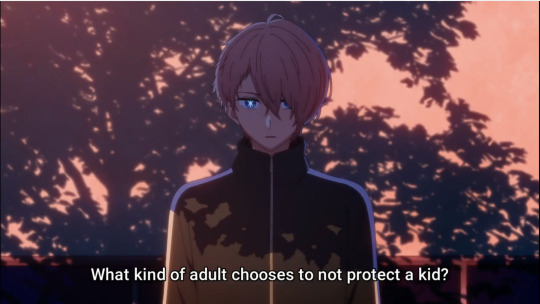
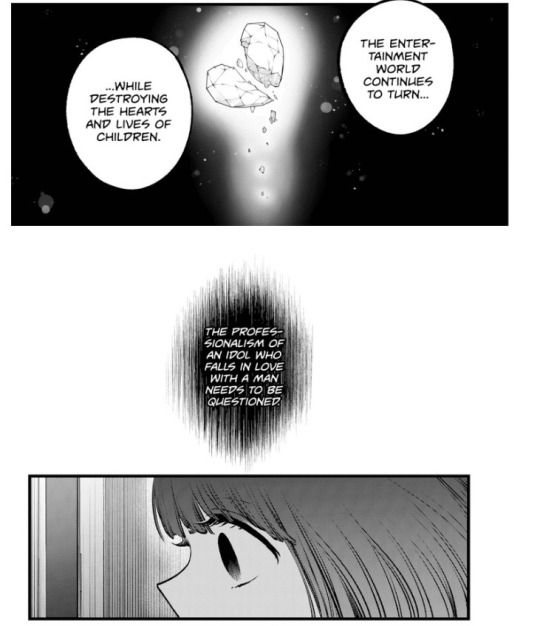
His path towards healing would involve taking a long look not just at the hurting child in himself, but the hurting child in Hikaru, too. Which is not the same as excusing. After all, we already saw what happened with Aqua thought his dad was dead: despite the supposed justice and his proclamations about being free, he was still every inch the trapped, terrified, traumatized child afraid to live. Killing Hikaru won't be any different.
Becoming Human
So, is there hope for Aqua?
Yeah. A ton of it.
Despite the tragedy of Ai's story, every other arc has ended optimistically. The story's optimism, also, is fundamentally rooted in humanity. Every character, even the ones who seem like exploitative jerks like the producers who edited Akane to look bad and the self-centered mangakas, end up having their thoughts and motives explored, and we see where they are coming from. Not only that, but they have the best of intentions.
Frankly, this is true to life as well. Precious few people see themselves as the villain. Almost everyone thinks they're doing the right thing. It's very human.
The end of the reality dating show arc is kind of what I expect in the end here. There, all contestants came together and pooled their unique individual talents to exonerate Akane. I would expect Ruby, Miyako, Kana, and Akane (who herself has finally realized that she can step into her own personhood instead of trying to be Ai/whatever Aqua needs and vowed to stop him) to come together to save Aqua from himself.
Aqua is incredibly loved, and he doesn't seem to understand this. Love is what enabled Ai to die smiling. A lack of love, feeling undeserving of love, is what torments Sarina/Ruby, Aqua, Kana, and more. The bastardization of love is what torments Hikaru.
Love allows someone to be themselves, truly, to individuate. This is what Aqua needs to learn:

He also doesn't need to earn the love of those around him, nor the love of Ai. She loved him just because he was her son, and all she wanted was for him to be happy and to live.
Imo, it's pretty unlikely Akasaka plans to end the series with Aqua becoming Hikaru 2.0. My guess is that Hikaru will be stopped because of Aqua, and he'll even likely die, but not at Aqua's hand. I suspect Akane, Ruby, and especially Kana (the one person Aqua has consistently placed above Ai) will help save Aqua from himself.
#oshi no ko#onk#oshi no ko meta#aqua hoshino#ruby hoshino#ai hoshino#hikaru kamiki#kana arima#akane kurokawa#onk theory#onk meta
326 notes
·
View notes
Text
Flickering Lights

Chapter 1 - Prologue
(Chapter 2)
Read on AO3
Click for Masterpost
True Form Sukuna x Reader
NSFW I Explicit I Slow Burn
Warning: Graphic Depictions of Violence!
Summary: Living an unhappy, suffocating and lonely life in the city of Tokyo, you dream of change, an adventure, a different life even. Until fate comes along, making you clash with an unusual looking Stranger. A Stranger named Sukuna, who will change your life…
- Please read the tags carefully! I will keep adding tags while I keep publishing. This is a dark story. Please read at your own risk! -
Tags: True Form Sukuna, Sukuna is His Own Warning, Sukuna is a Little Shit, Four-Armed Sukuna, Sukuna Has Two Penises, Modern Era, Eventual Romance, True Form Sukuna is my King, Blood and Violence, dark content, References to Depression, Slow Burn, Slow Romance, Emotional Hurt, Corn With Plot, Corn with Feelings, Blood and Gore, Angst and Tragedy, Angst, Murder, Angst and Voyeurism, Romance, Drug Use, Past Drug Use, Vomiting, toxic behaviour, Voyeurism, Rough Sx, Dirty Talk, Flirting, DP, Girls Kissing, Public Sx, Masturbation, Grief/Mourning, Codependency, mama I'm in love with a criminal, Hybristophilia, Aphrodisiacs, Hurt No Comfort, Reader is Not a Jujutsu Sorcerer, No Jujutsu Society, Dead Dove: Do Not Eat
All Jujutsu Kaisen characters belong to Gege Akutami.
-
Your wheezing breath echoes through the place. White, damp air evaporates in front of your panting mouth. Eyes wide open, as you come to your senses, as you stare down at your trembling hands, buried in the shallow sea of white snow.
The air, cold as ice, stings in your lungs. With every breath you take, over and over and over again, it hurts deeper and deeper. Your throat feels parched, as if screaming has brought a drought upon your insides. Blood quietly soaks into the snow, as the remaining flesh of your cut off finger digs into the biting frost, numbing the remaining stump. Your knees feel sore, as the ice burns into your skin like fire, as you feel the hard ground beneath your fingertips, frozen mud and roots. The wet cold creeps into your clothes and your body like worms, tingling and biting on every inch of your skin. It numbs your senses, but not your feelings.
Because your heart is racing in your chest, wets your eyes and chokes your throat. The adrenaline makes your muscles twitch and jitter, makes you want to throw up, makes you want to panic and run.
But you can’t…
This is it.
Your bones are heavy, as you try to stand up. Slowly, carefully, your feet slide forward. You shift your weight and rise to your feet. Balance is difficult, as little pins and needles poke into your hands and face, makes you think you’re gonna faint. Your legs give in and you stumble to the side against a tree.
It’s wet.
Droplets of morning dew crawl upon the bark, as fog hangs between the ground and the treetops. Your eyes wander up. Like old, boney fingers, the naked branches reach into the grey flat sky.
Inhaling deeply, you fill your lungs with freezing air, wait until the pins and needles grow softer and softer, before you take a step forward.
Another. And another.
Leaving a bloody trail on the forests snow, you walk, but don’t know where to go. You just walk, following your heart and soul, as the freezing temperatures make you ignore the pain and dripping wound on your hand.
Step after step.
And after what feels like hours, you see an ice house. Walking closer, you spot footprints in the snow surrounding the Himuro. Some small, some big. Your heart picks up a beat, as you decide to follow the footprints, hoping to lead you anywhere.
Suddenly, a dark presence looms over the place, as you approach the edge of this empty forest.
And your steps grow slower. Jizōs, figures carved out of stones, appear on the side of the path. You keep walking, until a tall structure paints its silhouette through the fog behind the trees. Similar to a shinto shrine, but beastly in it’s appearance. With every step, it becomes more clear.
Dark.
Horns are protruding out of the roof, human skulls are dangling off the edge of it, like decoration. With a nervous heart, you notice the smell of old wood, death and bones in your nose, as you step closer and closer.
Closer and closer.
Dark clouds paint the grey sky above the shrine. Bovine skulls are piling up at its walls. Some huge, as if taken out from legends and tales.
And then, through the thinning fog and the bleak trees, a few yards in front of you, his silhouette appears, making you hold your breath and your heart ache. Sitting crosslegged on a wooden podium, with his black coated back facing to you. Faintly, you hear him chant, over and over again, meditating. Deeply concentrated.
It’s him.
His voice.
You don’t recognise the words, but his voice still feels so familiar to you.
Shivering, from the cold and anxiety, you make your way to him.
Quietly.
Closer.
With each step.
Closer.
To him.
Holding your breath, you anxiously hold onto the freezing bark of a tree of the forests edge, the last tree that’s standing between you and him, painting a red trace on it’s surface.
And your eyes grow wet.
There he is. Right in front of you, just a few steps apart.
So close.
Another step and a twig breaks, making his left ear twitch. Your breath hitches and you freeze, as he turns his head.
Crimson orbs lock with your brave ones. Four eyes on you.
And he makes you crumble under his gaze, as you see how his eyes widen at the sight of you. Makes your heart race, as you watch how his mouth slowly parts, but doesn’t speak.
And with quivering lips and a pounding heart, with a voice barely more than a breath, his name crawls across your lips.
“Sukuna-sama.”
#I’m sweating so much#So nervous#I hope you enjoy#Flickering Lights#Flickering Lights Chapters#sukuna#sukuna x you#sukuna x reader#jjk x you#jjk x reader#sukuna fanfiction#fanfiction#nighty writes#true form sukuna#true form sukuna x you#true form sukuna x reader#ryomen sukuna#sukuna ryomen#true form sukuna smut
126 notes
·
View notes